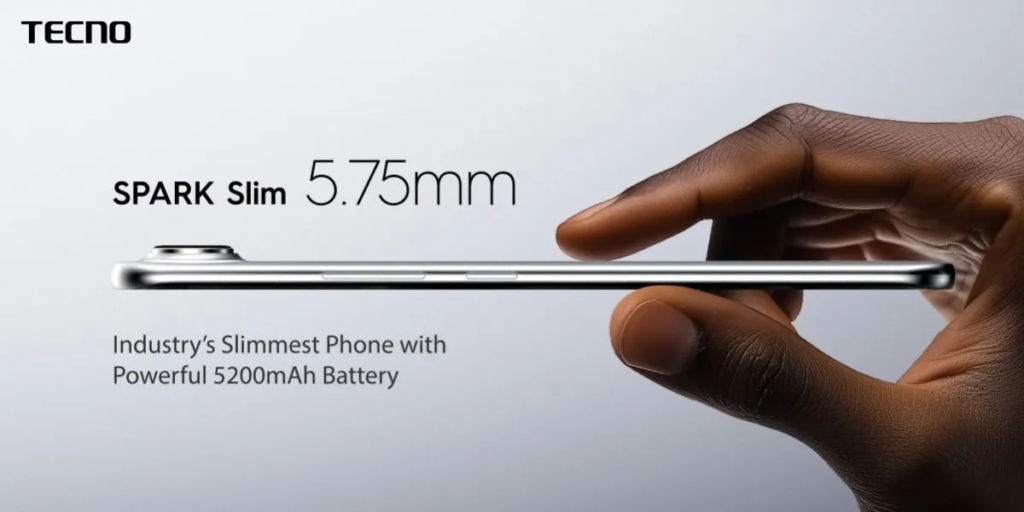The smartphone industry is no stranger to innovation, and 2025 is shaping up to be the year of ultra-slim devices. Leading the charge is Tecno, a brand known for pushing boundaries in mobile technology. At MWC 2025 (Mobile World Congress), Tecno is set to unveil its latest concept device, the Spark Slim, which could potentially claim the title of the world’s thinnest smartphone. But that’s not all—this sleek device also packs a surprisingly large battery, defying expectations for such a slim profile. Let’s take a closer look at what makes the Tecno Spark Slim a potential game-changer.
The Tecno Spark Slim: A Marvel of Engineering
The Tecno Spark Slim is designed to be a trailblazer in the ultra-thin smartphone category. Here are the key specs that make it stand out:
1. Unmatched Thinness
The Spark Slim boasts a jaw-dropping thickness of just 5.75mm, making it over 33% thinner than the Galaxy S25 Ultra (8.6mm) and nearly 2mm slimmer than the iPhone 16 (7.6mm). If released, it could easily claim the title of the world’s thinnest smartphone—at least until competitors like Apple potentially unveil the rumored iPhone 17 “Air” with a thickness of 5.5mm.
2. Impressive Battery Capacity
Despite its ultra-slim design, the Spark Slim doesn’t compromise on battery life. Tecno has managed to fit a 5,200 mAh battery into the device, which is 200 mAh larger than the battery in the Galaxy S25 Ultra. This is a remarkable achievement, considering the Spark Slim’s significantly thinner profile.
3. Cutting-Edge Battery Technology
The secret behind the Spark Slim’s slim yet powerful design lies in its use of silicone-carbon battery technology. This advanced tech, also employed by brands like OnePlus and Oppo, allows for higher energy density, enabling manufacturers to pack larger batteries into slimmer devices. For example, OnePlus has used this technology to fit 6,000 mAh batteries into its flagship models.
Is the Tecno Spark Slim Too Good to Be True?
While the Spark Slim’s specs are undeniably impressive, there’s a catch: it’s still just a concept. Tecno has a history of showcasing groundbreaking concept devices at MWC, many of which never make it to market. For instance, last year, the company unveiled a rollable smartphone concept that has yet to see the light of day.
In a statement, Tecno described the Spark Slim as a “boundary-pushing concept device” that showcases “advanced technologies and revolutionary materials.” The company emphasized that the device is designed to lead the next wave of ultra-thin smartphone design without compromising on performance.
The Challenges of Ultra-Thin Smartphones
While the idea of an ultra-thin smartphone is appealing, it comes with its own set of challenges:
1. Durability
Thinner devices are often more prone to bending or breaking, especially under pressure. Tecno will need to ensure that the Spark Slim is robust enough to withstand everyday use.
2. Thermal Management
Slimmer designs can lead to overheating issues, particularly when paired with high-performance components. Effective thermal management will be crucial to maintaining the device’s performance and longevity.
3. Market Demand
While ultra-thin smartphones are impressive, consumers often prioritize features like battery life, camera quality, and durability over slimness. Tecno will need to strike a balance between aesthetics and functionality to appeal to a broad audience.
What This Means for the Smartphone Industry

The Tecno Spark Slim represents a bold step forward in smartphone design. If Tecno can bring this concept to market, it could set a new standard for ultra-thin devices, challenging industry giants like Samsung and Apple to innovate further.
Potential Competitors
- Samsung Galaxy S25 Edge: Rumored to be 5.84mm thick, this device could be a direct competitor to the Spark Slim.
- iPhone 17 “Air”: Apple’s rumored ultra-thin iPhone, with a thickness of 5.5mm, could steal the spotlight if it launches before the Spark Slim.
The Future of Smartphone Design
The Spark Slim highlights the growing trend of combining sleek designs with powerful performance. As battery technology continues to evolve, we can expect to see more devices that defy traditional size constraints, offering both style and substance.
Should You Be Excited About the Tecno Spark Slim?
For tech enthusiasts, the Spark Slim is an exciting glimpse into the future of smartphone design. Its combination of ultra-thin form factor and impressive battery capacity is a testament to Tecno’s engineering prowess. However, until the device moves from concept to reality, it’s best to temper expectations.
A Bold Vision for the Future
The Tecno Spark Slim is more than just a concept—it’s a statement. By pushing the boundaries of what’s possible in smartphone design, Tecno is challenging the status quo and inspiring the industry to think differently. Whether or not the Spark Slim makes it to market, its unveiling at MWC 2025 is a reminder that innovation is alive and well in the world of mobile technology.
As we wait to see if the Spark Slim becomes a reality, one thing is clear: the race to create the world’s thinnest smartphone is heating up, and Tecno is leading the charge.








